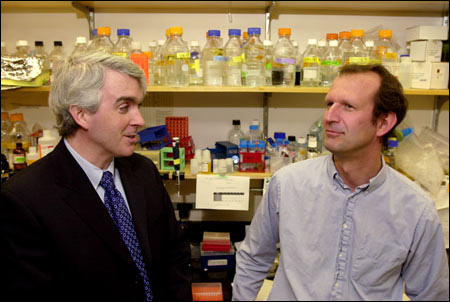Lung cancer vaccine under development:
Results are encouraging

Medical investigators have begun to see some light at the end of a long tunnel that may lead to a vaccine against lung cancer.
A trial vaccine given to 25 patients in advanced stages of the disease has produced what researchers call “encouraging results.” Lung cancer is the leading cause of cancer deaths in North America and Europe. More people die of it than of breast, prostate, and colon cancer combined.
The vaccine is therapeutic rather than preventive, designed to allow patients to live longer, not to prevent the disease.
“Lung cancer is so hard to deal with because, in most patients, it has already spread beyond the lungs before it is detected,” says Glenn Dranoff, associate professor of medicine at the Harvard Medical School. “Most of these people don’t live longer than a year.”
Eighteen of the 25 patients who received the vaccine showed signs that it stimulated their body’s natural immune system to mount a heightened attack against the tumors. Three of the survivors are still alive as long as 43 months after receiving treatment.
Pieces of tumor recovered from six patients showed that, in three of them, immune-system proteins penetrated into the tumors and killed many of their cells. That kind of result is heartening considering that prior surgery and chemotherapy had severely weakened the natural protection given by their own immune systems. No toxic side effects occurred in any of the patients.
These experiments were not done to effect a cure, but, as required by the Food and Drug Administration, to test the vaccine’s safety. It passed with a high grade. The experimenters, who work at the Dana-Farber Cancer Institute and several other Harvard-affiliated hospitals in Boston, reported their results in the Feb. 15 issue of the Journal of Clinical Oncology.
Dranoff, who led the team, says he is not aware of any other academia group working on this type of lung-cancer vaccine. He and other team members originally developed it to treat patients with advanced melanoma, a skin cancer that becomes lethal if allowed to spread. “The vaccine has also passed safety trials for melanoma,” Dranoff says, “and we have begun testing it on ovarian cancer and leukemia patients.”
Custom-tailored vaccines
The next step is to carry out trials of the vaccine with patients in earlier stages of lung cancer and melanoma.
“When found before they spread, lung tumors can be removed by surgery, but nothing we know of prevents them from reappearing,” Dranoff explains. “Once the tumors spread, we treat people with chemotherapy. That makes them feel better for a short time, then the drugs become ineffective. Our goal is to evaluate the vaccine on patients who have localized tumors removed by surgery. If we can prevent their malignancy from reappearing and spreading, then the vaccine would be a success.”
Rather than a one-fits-all generic vaccine, Dranoff’s team uses a custom-tailored approach. Part of a lung tumor is removed, then a gene that produces an immune-stimulating protein is inserted into a harmless virus and the combination put back into the patient. The protein, known as GM-CSF (granulocyte-macrophage colony-stimulating factor), kick starts an immune reaction against the tumor cells.
In 18 of 25 patients (72 percent), evidence indicates that such a customized vaccine initiated an immune attack on the tumors, and did so without any harmful side effects. This approach worked the same way in melanoma patients. “That’s quite encouraging,” Dranoff says. “It tells us we’re on track to understanding how the immune system responds to tumor cells and how we can use that information for treatment.” In other words, they’re on track to reach the end of the tunnel.
But the tunnel is dark and not without other obstacles. Vaccines against foreign invaders initiate potent attacks on foreign viruses and bacteria, but tumors are not that foreign; they’re part of the “self.” Once initiated, an immune attack needs reinforcement. “We’re now studying ways to increase the magnitude of the immune response after its initiation,” Dranoff says. “The result will probably be multiple forms of immune treatment to make the vaccine more effective.”
Tests with patients in earlier stages of lung cancer and melanoma will involve many more people at different places around the country. Such Phase II trials, as they are known, are logistically impossible for most academic research labs to do. Pharmaceutical or biotechnology companies often join the effort at this point. Cell Gensys, a company in Fulton City, Calif., has begun such tests on the lung cancer vaccine. The company also has started Phase II trials with a prostate cancer vaccine that uses GM-CSF.
Learning from tumors
Meanwhile, Dranoff and his colleagues study the patients and tumors that had the best responses to their vaccine. This is more difficult to do with lung tumors than with more easily accessible skin malignancies. That’s why the customized approach was started with melanoma in the first place.
After successful experiments with animals, Dranoff and Richard Mulligan, now Mallinckrodt Professor of Genetics at Harvard Medical School, began working with melanoma patients in 1994. It was 1997 before they felt they knew enough to try the vaccine on lung tumors. The many colleagues they worked with on developing the first lung vaccine include Ravi Salgia of the Dana-Farber Cancer Institute and Thomas Lynch of Massachusetts General Hospital.
The work ahead involves closely studying the tumors that showed the best response to the lung cancer vaccine, then comparing them with those that showed the least beneficial effects. The results should shed more light into the parts of tunnel ahead.
The eventual goal is to develop a vaccine that will not just add more years to the lives of lung cancer and other cancer patients but will prevent these diseases from developing in the first place. In the meantime, Dranoff notes, “We have long-term survivors from the lung and melanoma trials, and we’re learning lots of important things from them.”




